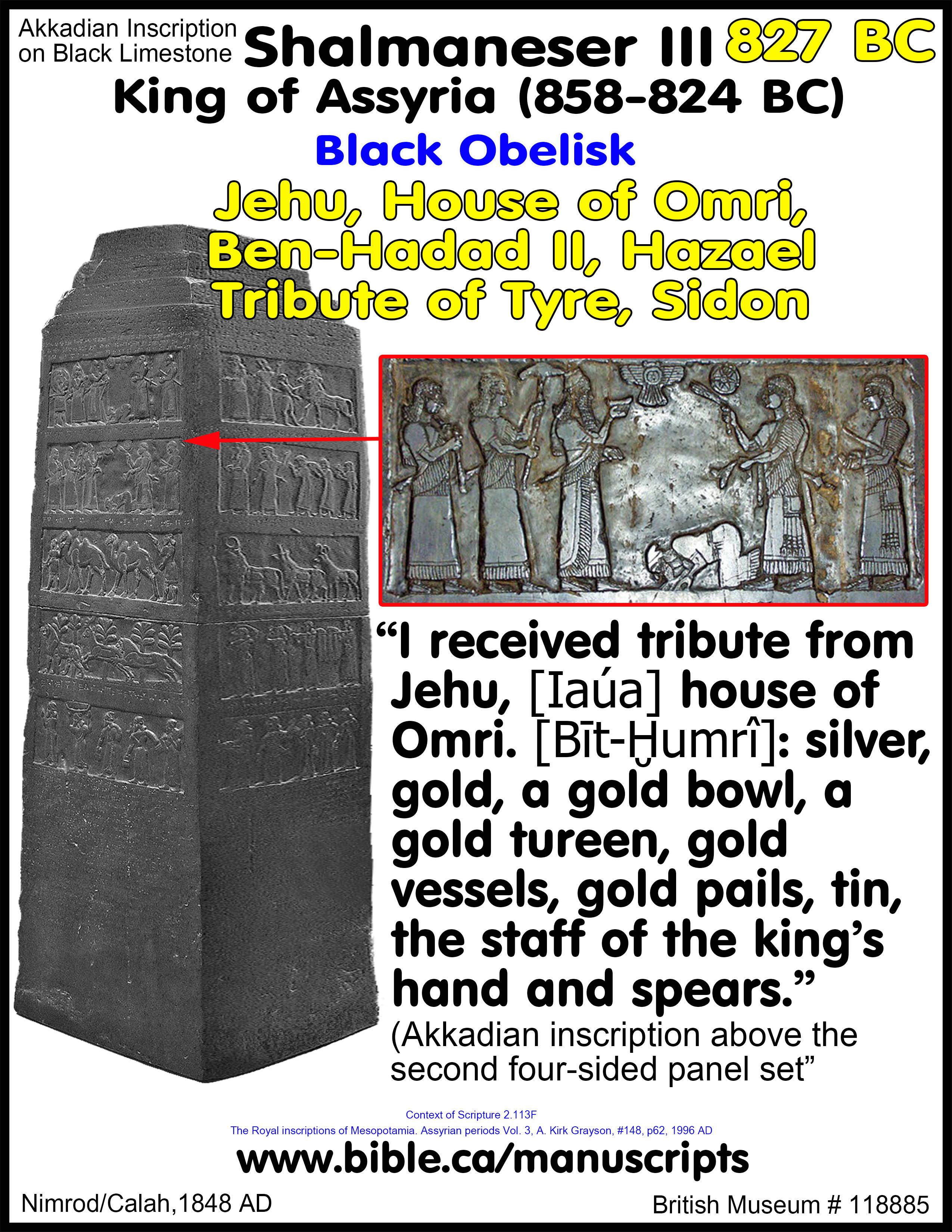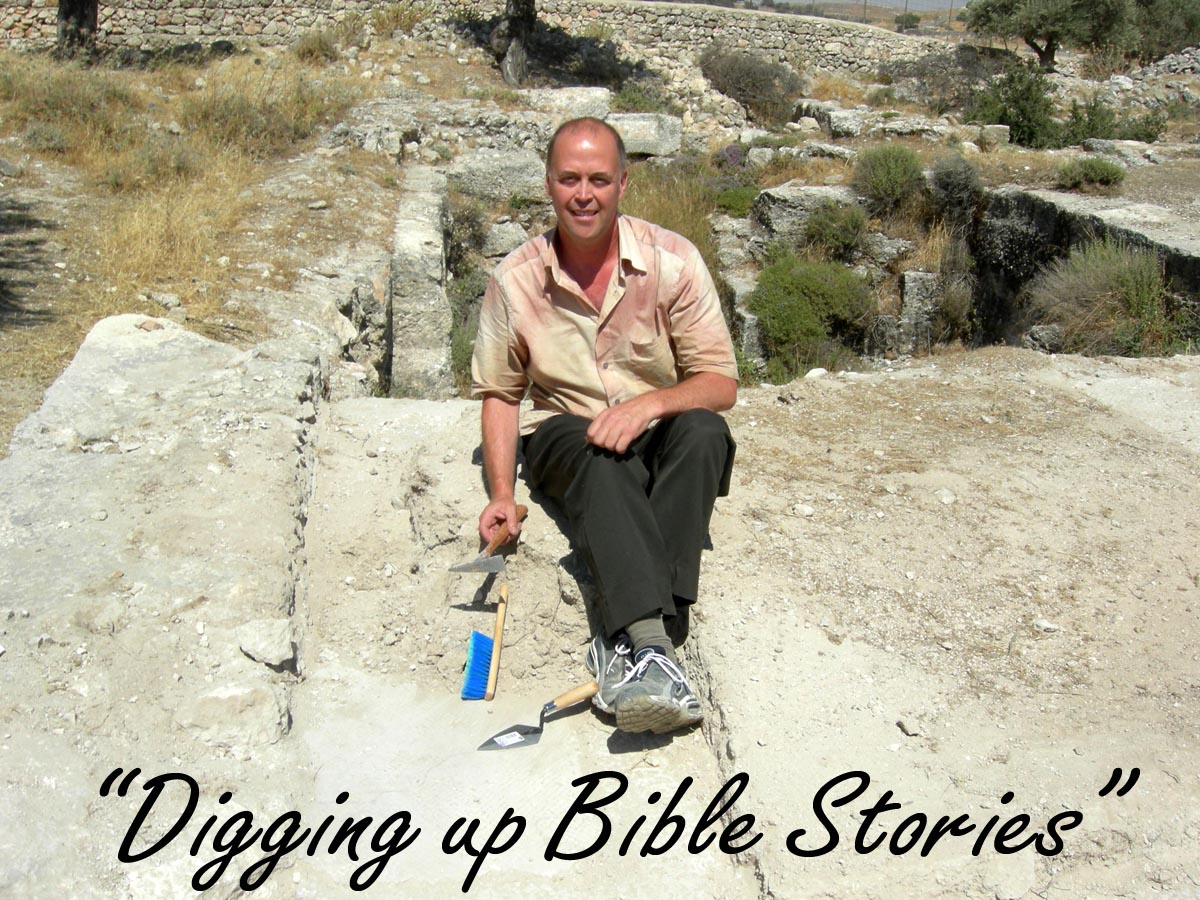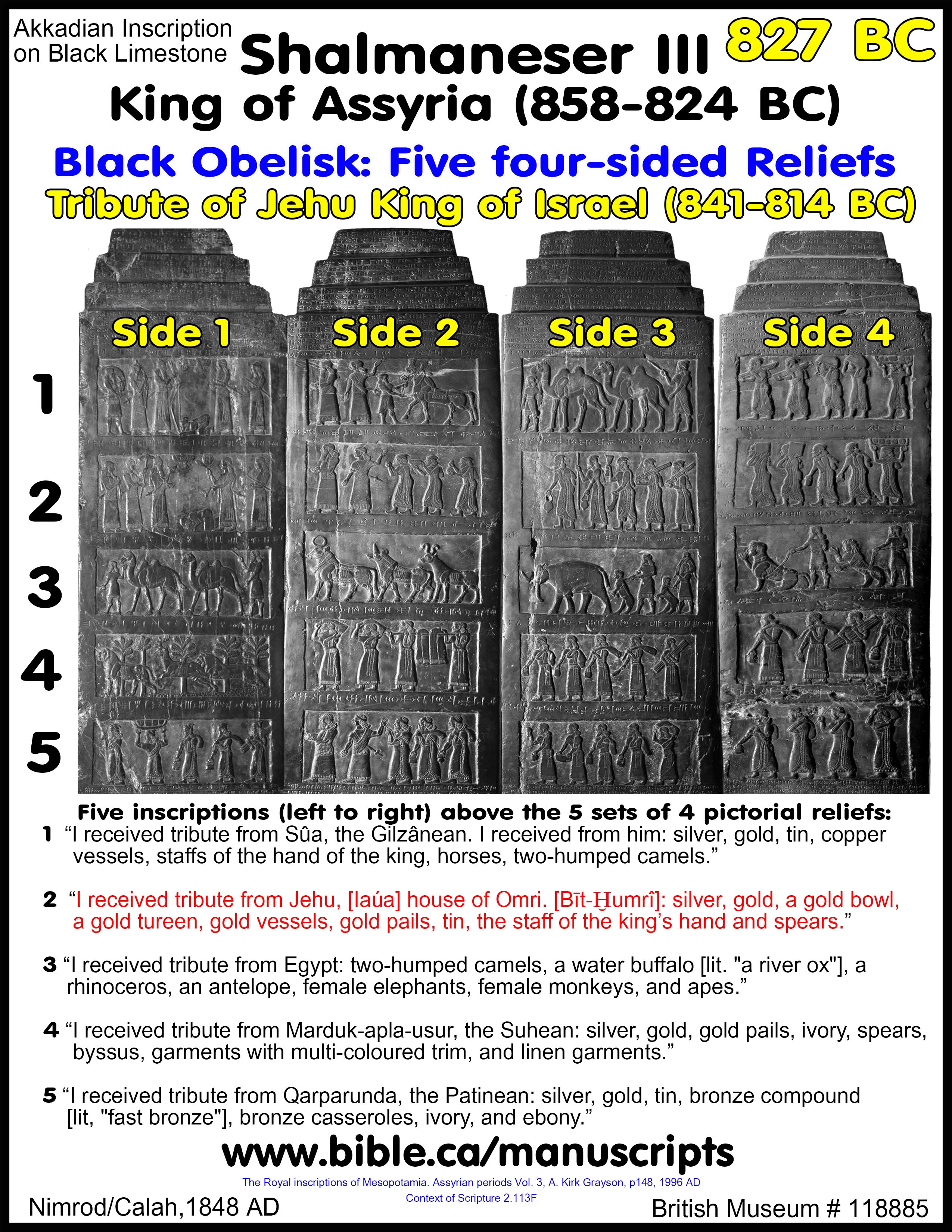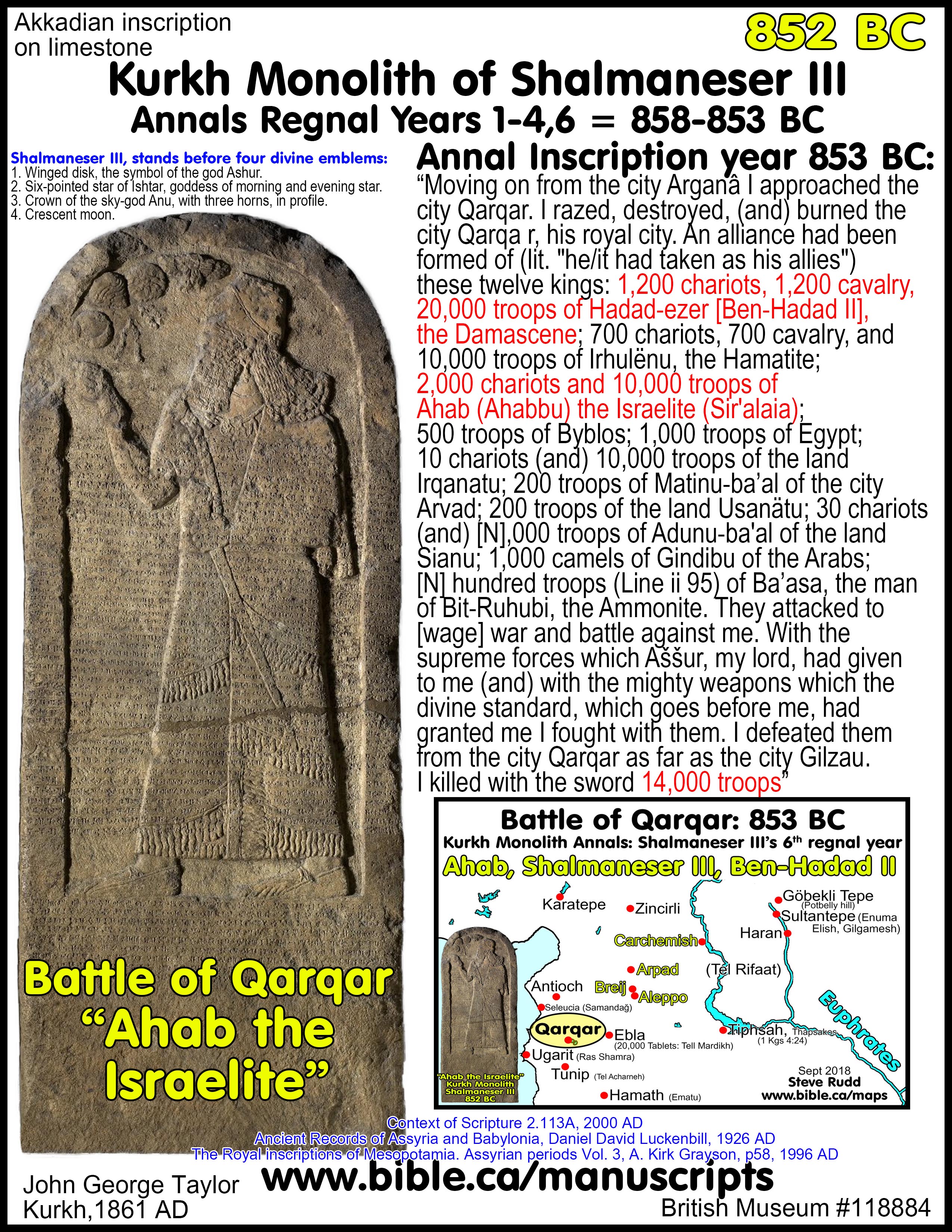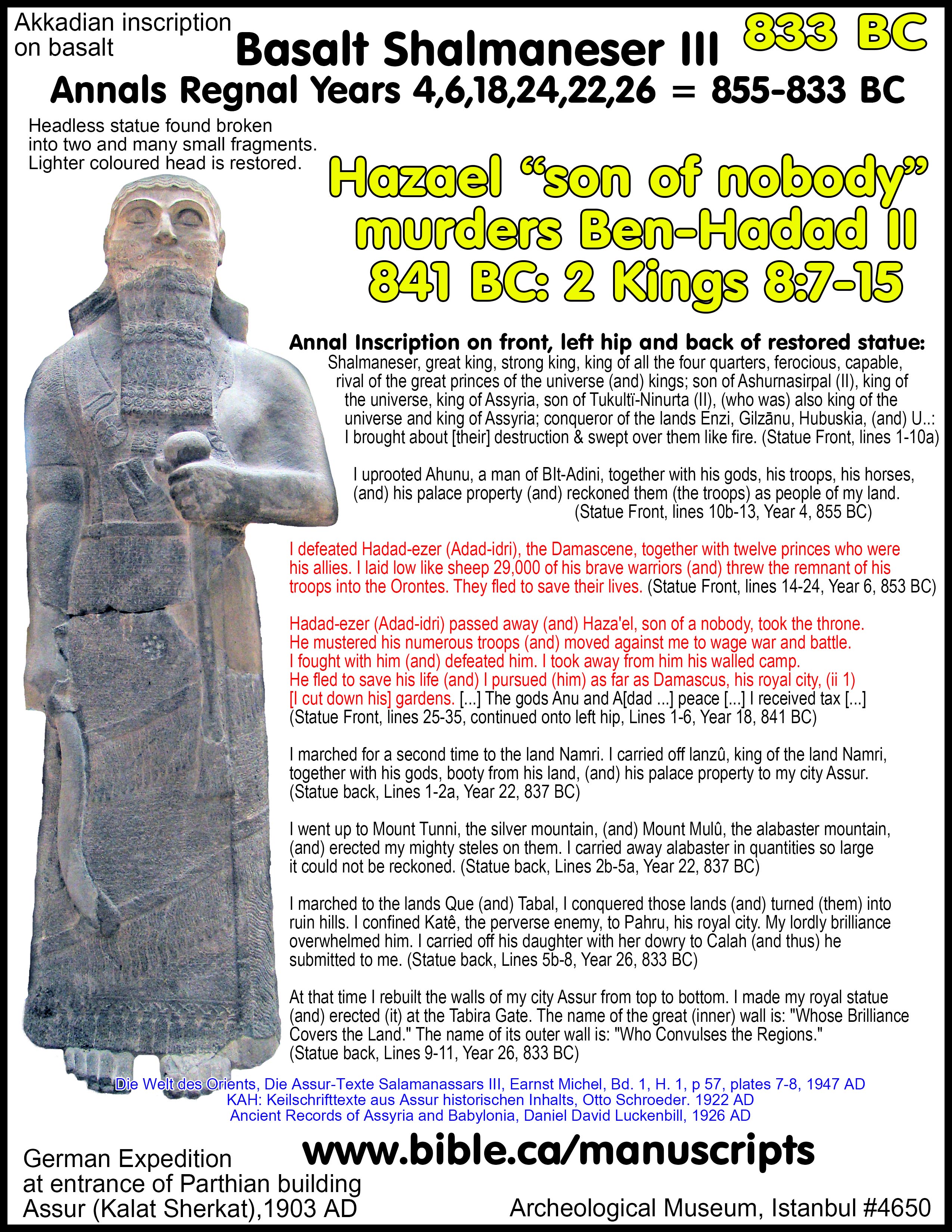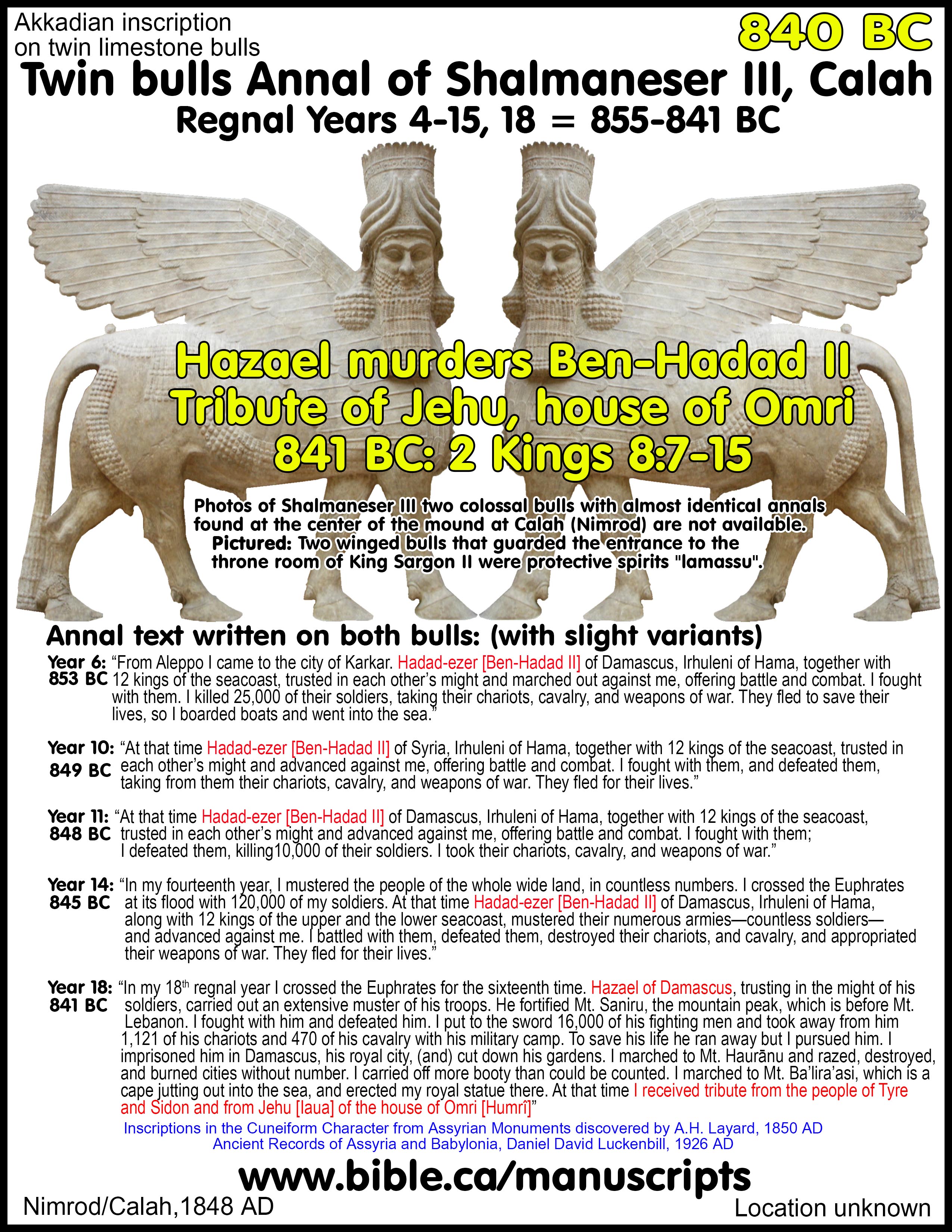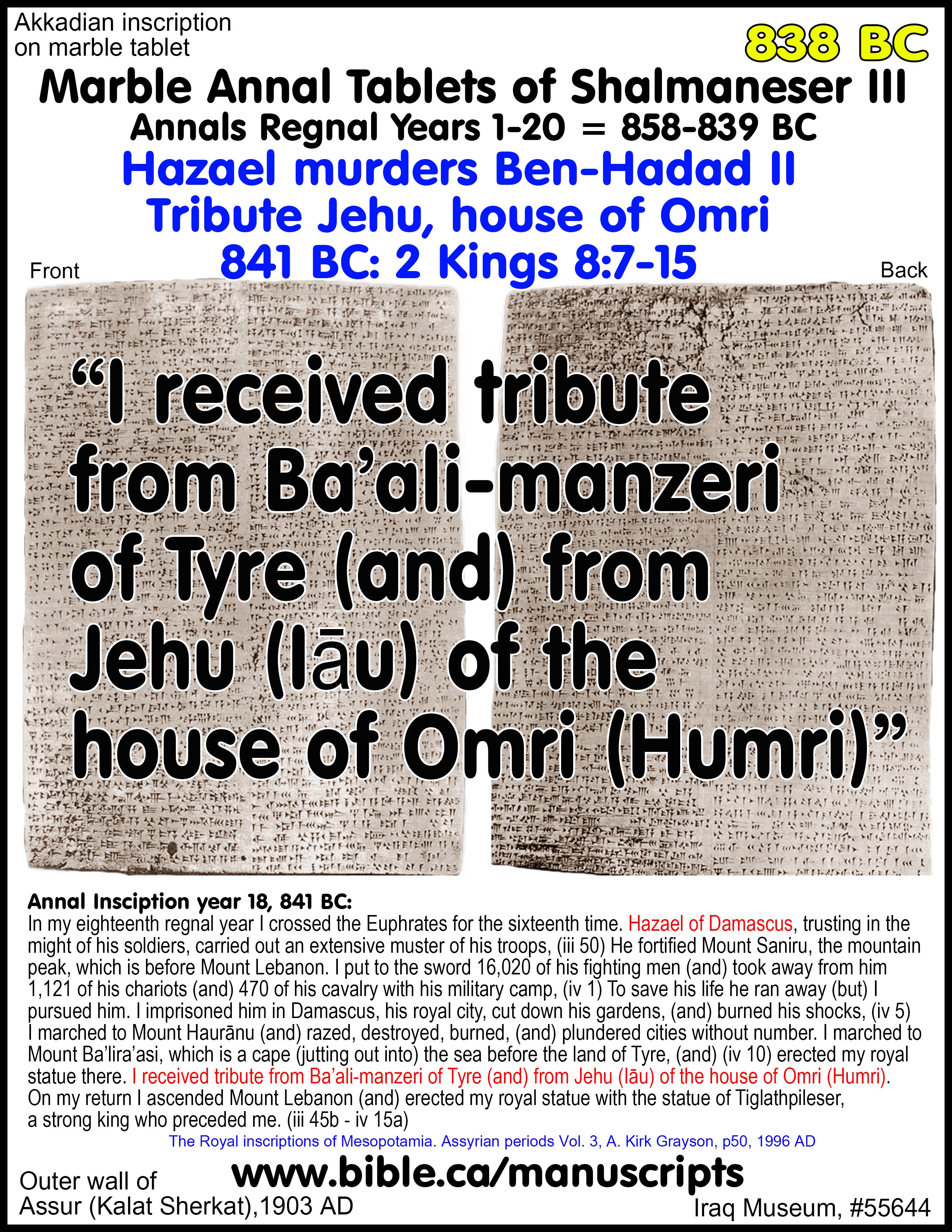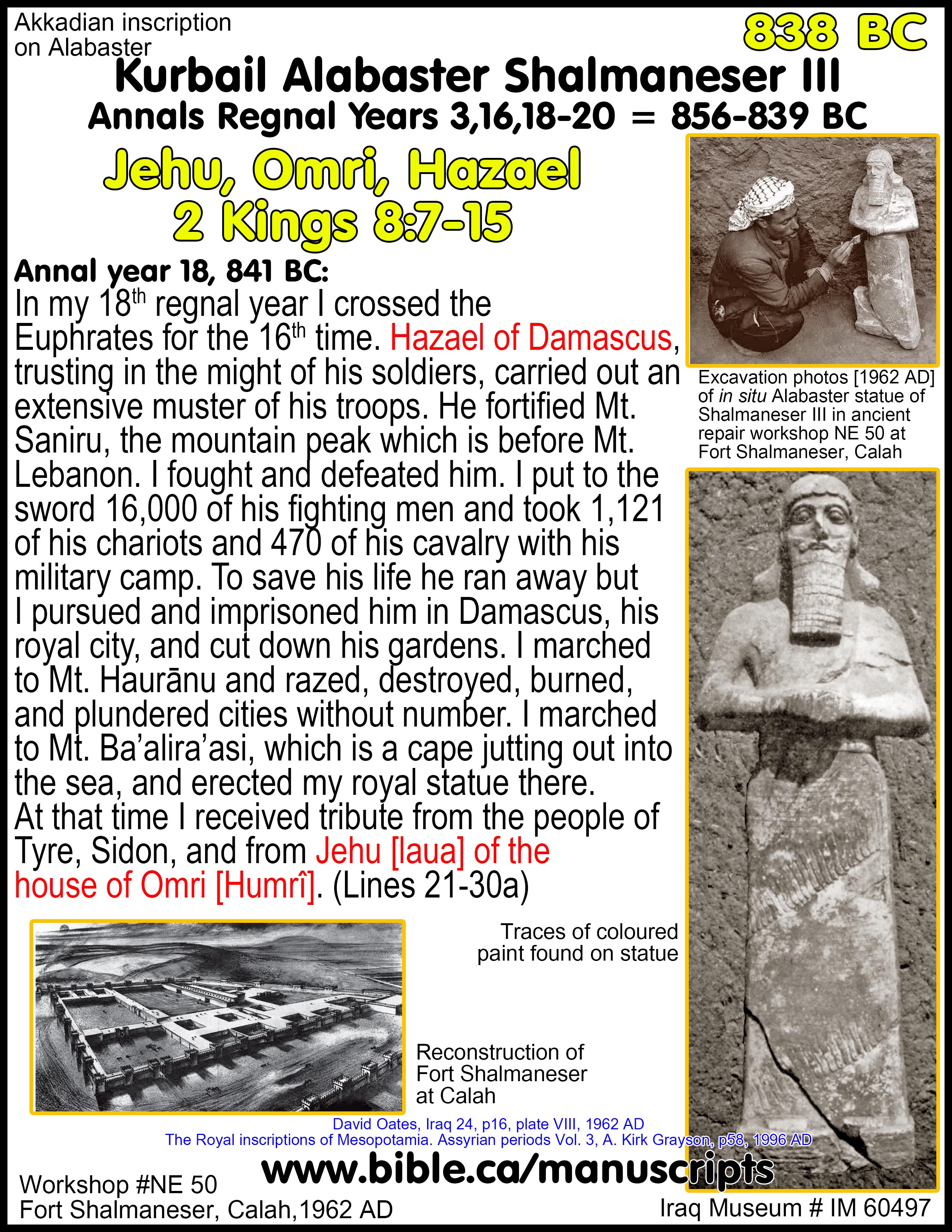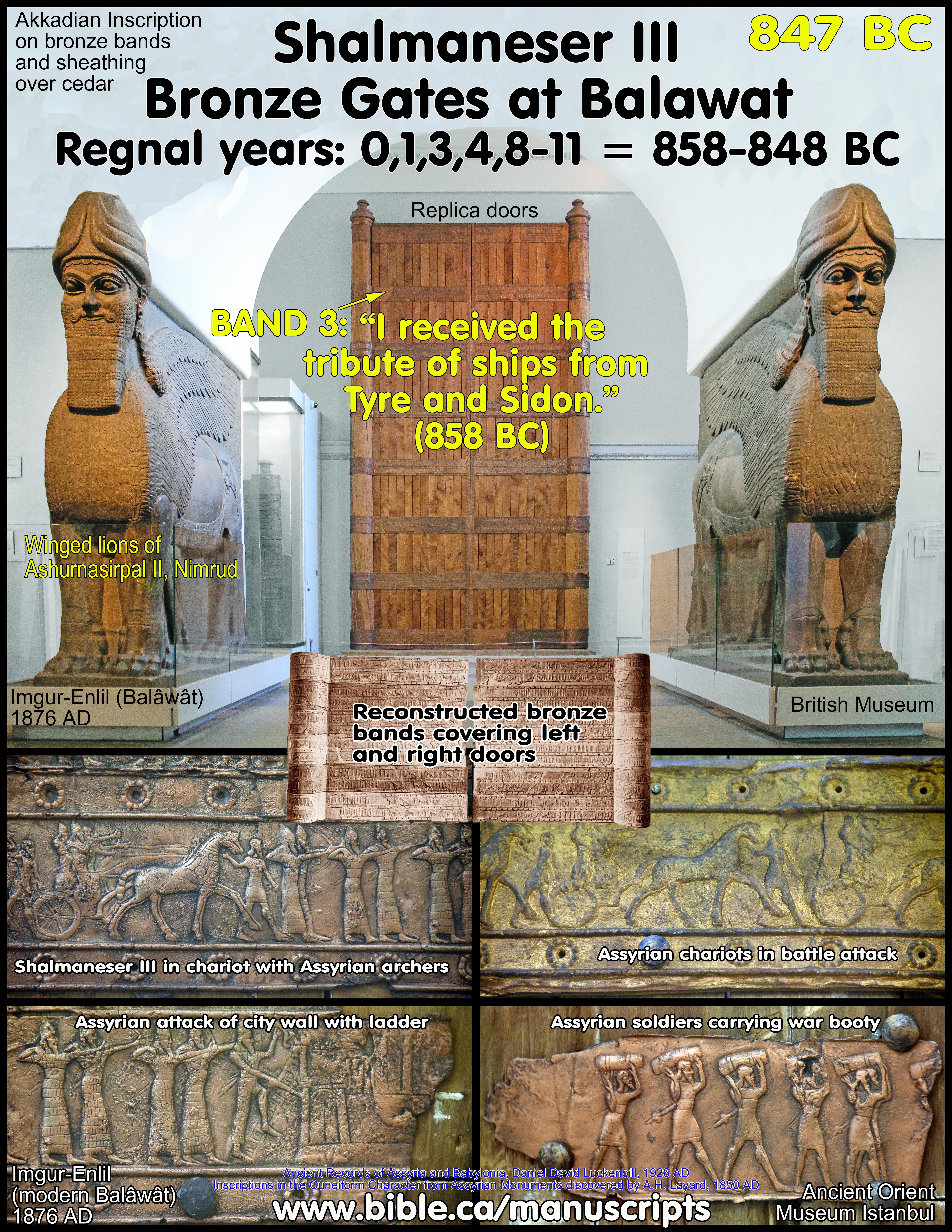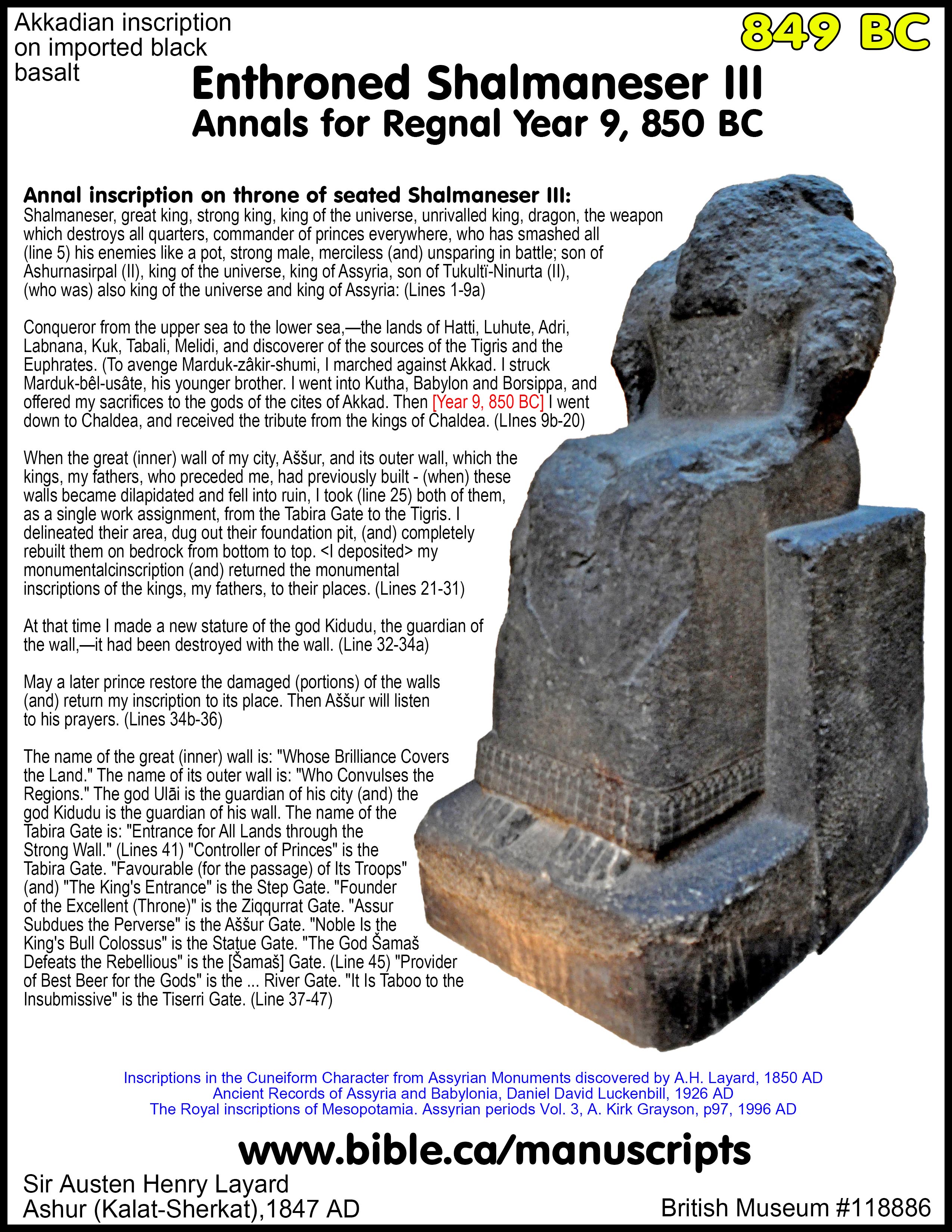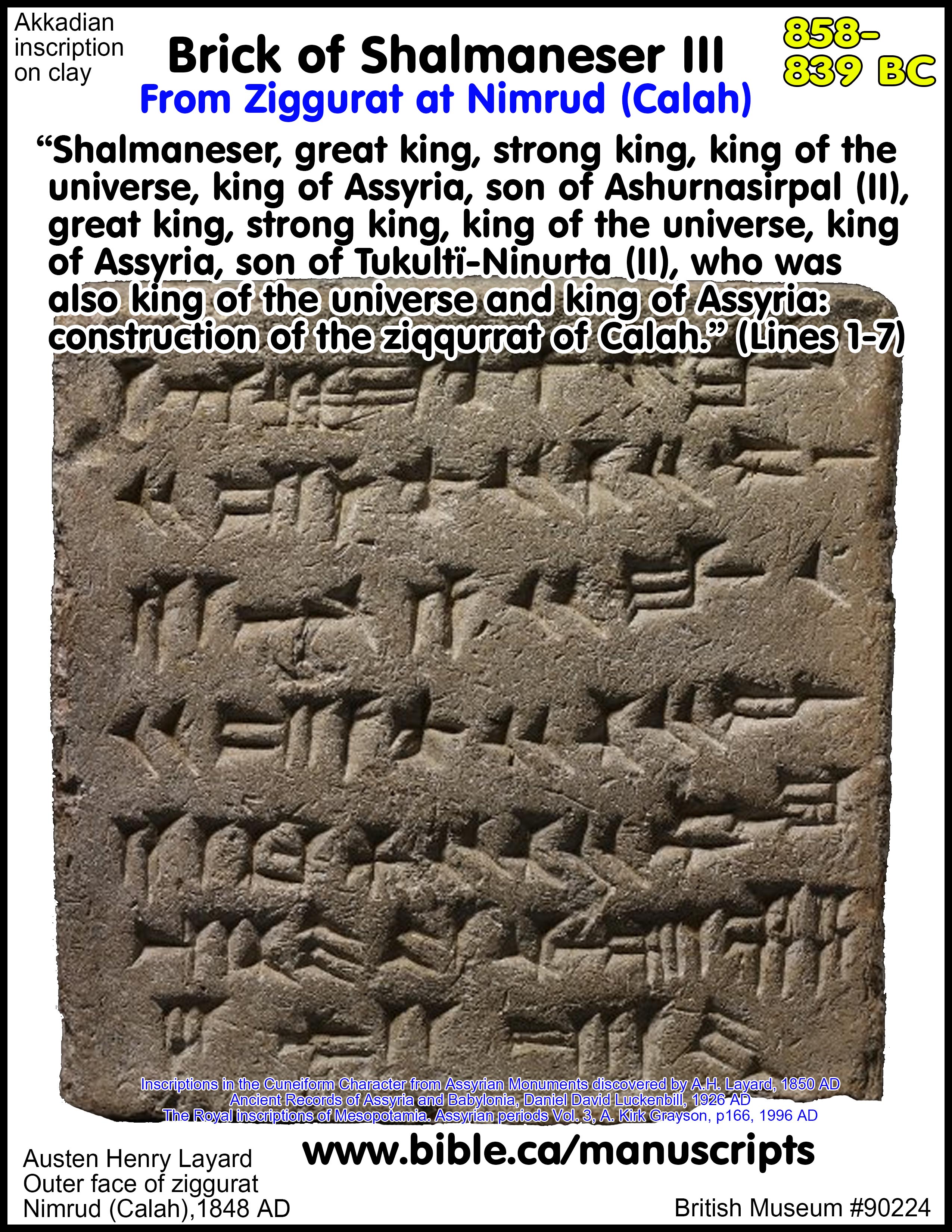Black Obelisk of Shalmaneser III: 827 BC
Shalmaneser III, King of Assyria 858-824 BC
“Jehu, House of Omri, Ben-Hadad II, Hazael, Tyre, Sidon”
See also: Detailed outline on Shalmaneser III
|
Black Obelisk of Shalmaneser III |
|
|
Date of inscription |
827 BC |
|
Annal years |
858-828 BC |
|
Glyptic object |
Akkadian Inscription on Black Limestone |
|
Discovery |
Nimrod/Calah, 1848 AD |
|
Current location |
British Museum # 118885 (replica at Chicago Oriental museum) |
|
Bible names |
Jehu, Omri, Ben-Hadad II, Hazael, Tyre, Sidon |
|
Historic events |
Six battles between Israel (Ahab, Jehoram and Jehu) and Assyria: It highlights the ongoing battles between Shalmaneser III of Assyria and the coalition of 12 kings under the command of Ben-Hadad II: 1. 853 BC, year 6. The battle of Qarqar 2. 849 BC, Year 10: Battle of Carchemish 3. 848 BC, Year 11: Battle of Hamath 4. 845 BC, Year 14: Battle of Hamath 5. 841 BC, Year 18: Siege of Damascus 6. 838 BC, Year 21: Battle of Aram |
|
Digging up Bible stories! “I received tribute from Jehu, [Iaúa] house of Omri. [Bīt-Ḫumrî]: silver, gold, a gold bowl, a gold tureen, gold vessels, gold pails, tin, the staff of the king’s hand and spears.” (Relief 2) “In the twenty-first year of my reign, I crossed the Euphrates for the twenty-first time. I advanced against the cities of Hazael of Aram. I captured four of his cities. I received the gifts of the Tyrians, Sidonians, and Gebalites. (838 BC, Year 21, Lines 102-104) “What we read in the book, we find in the ground” |
Introduction:
1. Importance of the Kurkh monolith for Bible students:
a. Most important is the famous reference to King Jehu of the house of king Omri: “I received tribute from Jehu, [Iaúa] house of Omri. [Bīt-Ḫumrî]: silver, gold, a gold bowl, a gold tureen, gold vessels, gold pails, tin, the staff of the king’s hand and spears.”
b. Eponymy of [governor] Daiiān-Aššur: During this period of Assyrian history, each year was named after one of the governors within the Assyrian empire. This allows us to synchronize Assyrian to Bible chronologies and generate specific historic dates.
2. Six battles with Israel:
a.
853 BC, year 6. The battle of Qarqar where Shalmaneser III warred against Ben-Hadad II and
his coalition of 12 kings, one of whom was Ahab: “I
received gifts from all the kings of Hatti. At that time Hadad-ezer [Ben-Hadad
II] of Aram”
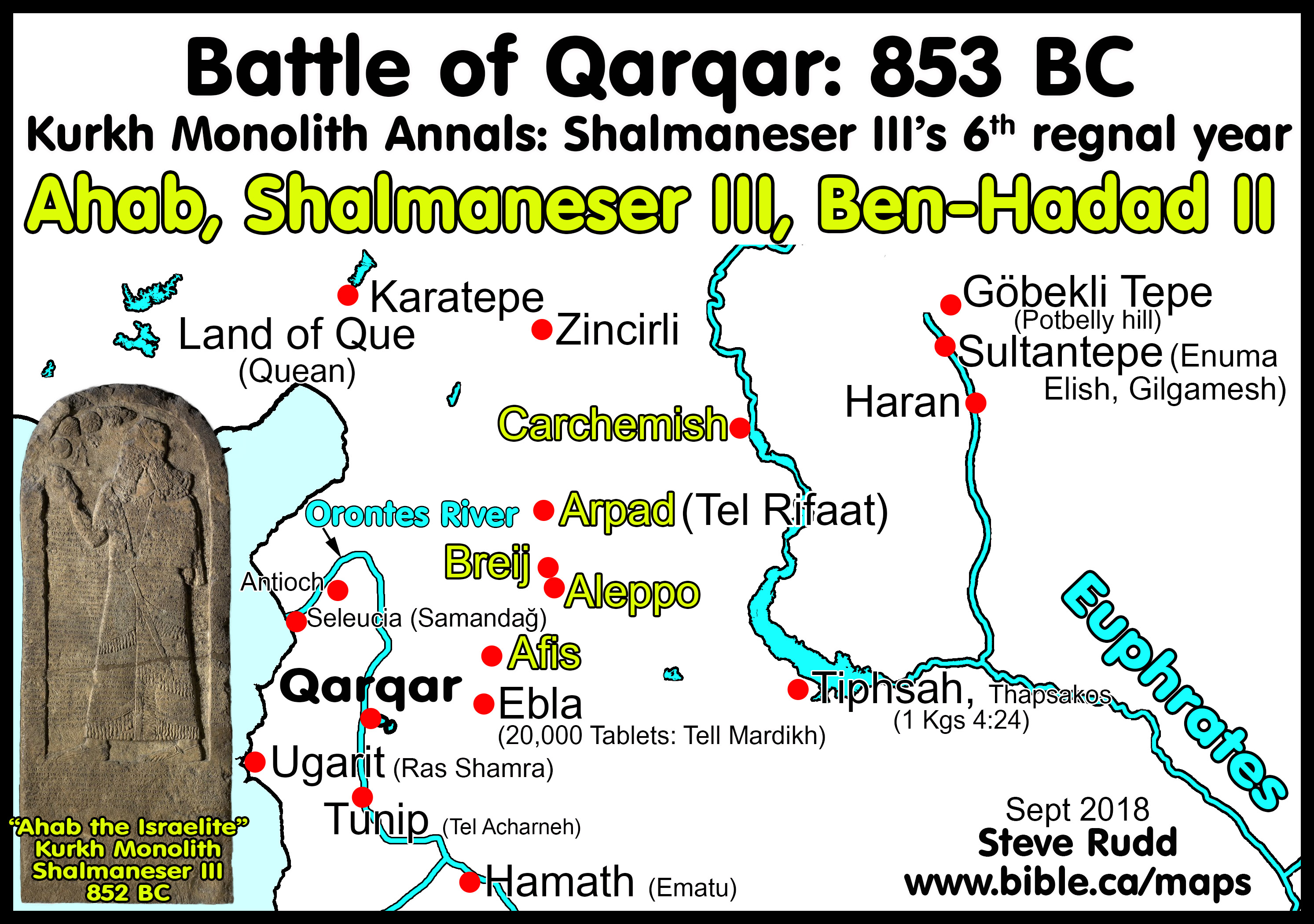
b. 849 BC, Year 10: Battle of Carchemish with Ben-Hadad II and 12 kings, one of whom was Jehoram, king of Israel: [Note: Battle at Carchemish, then War with 12 kings Aram, Samaria] “In the tenth year of my reign, I crossed the Euphrates for the eighth time. I captured the cities of Sangara of Carchemish. I advanced against the cities of Arame. I captured Arnê, his royal city, together with 100 of his small cities.” (Lines 85-86)
c. 848 BC, Year 11: Battle of Hamath: War with Ben-Hadad II and 12 kings, one of whom was Jehoram, king of Israel: “In the eleventh year of my reign, I crossed the euphrates for the ninth time. I captured countless cities. I descended upon cities of the land of Hamath. I captured 89 cities. Hadad-ezer [Ben-Hadad II] of Aram and twelve kings of the land of Hatti stood by each other. I was successful in overthrowing them.” (Lines 87-89)
d. 845 BC, Year 14: Battle of Hamath: War with Ben-Hadad II and 12 kings of Aram, Samaria, one of whom was Jehoram, king of Israel:
i. “In the fourteenth year of my reign, I mustered my land. I crossed the Euphrates. Twelve kings advanced to meet me. I battled with them and successfully overthrew them.” (Lines 92-93)
e. 845 BC, Year 14: The Melqart Stele was erected by Ben-Hadad II in preparation for this battle.
i. The stele was erected as a kind of “rabbit’s foot” lucky charm to invoke the assistance of the pagan god named “Melqart”.
ii. Of course, Shalmaneser was also invoking the assistance of his own pagan god’s names “Assur”.
iii.
See also full outline on Melqart
Stele
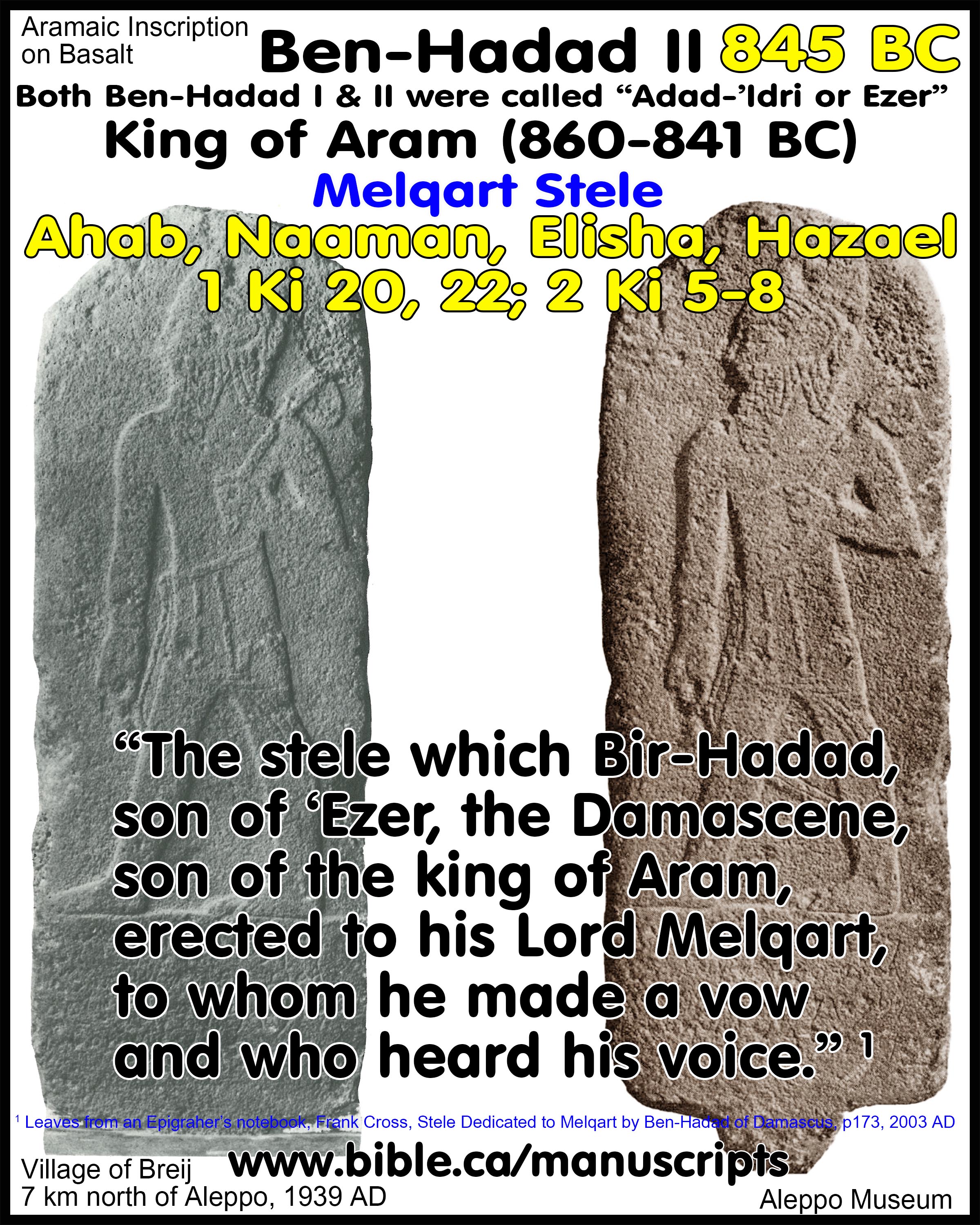
f. 841 BC, Year 18: Siege of Damascus: against Hazael: “Hazael of Damascus attacked to do battle. I captured from him 1,121 of his chariots (and) 470 of his cavalry, together with his camp”
g. 838 BC, Year 21: Battle of Aram: “In the twenty-first year of my reign, I crossed the Euphrates for the twenty-first time. I advanced against the cities of Hazael of Aram. I captured four of his cities. I received the gifts of the Tyrians, Sidonians, and Gebalites [Byblos].” (Lines 102-104)
3. Sources:
a. Context of Scripture 2.113F, 2000 AD
b. The Royal inscriptions of Mesopotamia. Assyrian periods Vol. 3, A. Kirk Grayson, p62, 148, 1996 AD
4. See Detailed outline on Shalmaneser III
I. About the Black Obelisk:
1. “This text is on the famous "Black Obelisk" discovered by Layard at Calah in 1846, The obelisk is remarkably free of damage in all but a few minor places, which can easily be restored. It has four sides, on each of which there are five panels of reliefs portraying scenes of the king's exploits and above each panel there is an epigraph describing the scene in words. Above and below the five panels of reliefs, on all four sides, is a continuous text, the text edited here. The epigraphs are edited separately as A.0.102.87-91. The text is the fullest and one of the latest accounts of the military campaigns of Shalmaneser, providing a narrative for every regnal year down to and including his thirty-first year (828 BC). The engraver ran out of space at this point and there is neither a description of building nor concluding formulae. The text was, then, composed late in 828 BC, or more probably in 827 BC. The inscription begins with an invocation of gods (lines 1-14) and the royal name and epithets (lines 15-21). This is followed by the narrative of the campaigns (lines 22-190) and much of this is similar to the narrative in the broken statue inscription from Calah, although there are frequently variations (A.0.102.16). The last few campaigns (lines 141-90) were led not by the king but by his field marshal, Daiiān-Aššur. This unusual circumstance caused some confusion for the scribe, as it did for the scribe of A.0.102.16, who fluctuated between third person (Daiiān-Aššur) and first person (the king) in the narrative. In the translation I have consistently used third person in these passages but put an asterisk after the pronoun where the text actually has first person.” (The Royal inscriptions of Mesopotamia. Assyrian periods Vol. 3, A. Kirk Grayson, p62, 1996 AD)
2. “COMMENTARY The obelisk (BM 118885 = 48-11-4,1) is about two metres in height and has been collated. There is some uncertainty regarding its exact provenance at Calah (see Gadd). All bibliography, except specific references to individual epigraphs, is included below. The beginning of this text (lines 1-47) is identical, with minor variants, to A.0.102.15. Therefore this latter text has been edited here as "ex. 2" for the sake of convenience. A few restorations in the master line have been made from "ex. 2." The interested reader can check the scores for details.” (The Royal inscriptions of Mesopotamia. Assyrian periods Vol. 3, A. Kirk Grayson, p62, 1996 AD)
II. Five pictorial reliefs on the Black Obelisk:
1. The Black Obelisk of Shalmaneser III tells 5 stories of conquest.
a. There is an inscriptions above the each of the 5 sets of pictorial 4 reliefs on each of the four sides..
b. Each of the 5 tribute texts are pictured with 4 panels that run horizontally around the stele that read left to right, starting with the first panel.
2. Translation of the 5 relief stories:
a. Tribute of Sûa, the Gilzânite. I received from him: silver, gold, lead, copper vessels, staves for the hand of the king, horses, two-humped camels.
b. “Tribute of Jehu, [Ia-ú-a] of house of Omri. [Bīt-Ḫumrî] I received from him: silver, gold, a golden bowl, a golden goblet, golden cups, golden buckets, tin, a staff of the king’s hand, javelins.” (COS 2.113F)
c. Tribute of the land of Musri. I received from him: two-humped camels, a river-ox, a sakêa, a sûsu, elephants, monkeys, apes.
d. Tribute of Marduk-apal-usur of Suhi. I received from him: silver, gold, pitchers of gold, ivory, javelins, bûia, brightly colored linen garments.
e. Tribute of Karparunda of Hattina. I received from him: silver, gold, lead, copper, copper vessels, ivory, cypress (timbers).
III. Translation of the Black Obelisk
|
Date Regnal Year Nisan |
Translated Text |
|
Other details |
Inscriptions above the 5 sets of pictorial 4 reliefs. Each of the 5 tribute texts are pictured with 4 panels that run horizontally around the stele that read left to right, starting with the first panel: 1. Tribute of Sûa, the Gilzânite. I received from him: silver, gold, lead, copper vessels, staves for the hand of the king, horses, two-humped camels. 2. “Tribute of Jehu, [Ia-ú-a] of house of Omri. [Bīt-Ḫumrî] I received from him: silver, gold, a golden bowl, a golden goblet, golden cups, golden buckets, tin, a staff of the king’s hand, javelins.” (COS 2.113F) 3. Tribute of the land of Musri. I received from him: two-humped camels, a river-ox, a sakêa, a sûsu, elephants, monkeys, apes. 4. Tribute of Marduk-apal-usur of Suhi. I received from him: silver, gold, pitchers of gold, ivory, javelins, bûia, brightly colored linen garments. 5. Tribute of Karparunda of Hattina. I received from him: silver, gold, lead, copper, copper vessels, ivory, cypress (timbers). |
|
Jan 858 BC Year 0 intro |
Assur, the great lord, king of all the great gods; Anu, king of the Igigi and Anunnaki, the lord of lands; Enlil, the exalted, father of the gods, the creator; Ea, king of the Deep, who determines destiny; Sin, king of the tiara, exalted in splendor; Adad, mighty, pre-eminent, lord of abundance; Shamash, judge of heaven and earth, director of all; Marduk, master of the gods, lord of law; Urta, valiant one of the Igigi and the Anunnaki, the almighty god; Nergal, the ready, king of battle; Nusku, bearer of the shining scepter, the god who renders decisions; Ninlil, spouse of Bêl, mother of the great gods; Ishtar, lady of conflict and battle, whose delight is warfare, great gods, who love my kingship, who have made great my rule, power, and sway, who have established for me an honored, an exalted name, far above that of all other lords! Shalmaneser, king of all peoples, lord, priest of Assur, mighty king, king of all the four regions, Sun of all peoples, despot of all lands; son of Assur-nâsir-pal, the high priest, whose priesthood was acceptable to the gods and who brought in submission at his feet the totality of the countries; glorious offspring of Tukulti-Urta, who slew all of his foes and overwhelmed them like a deluge. (Lines 1-21) |
|
858 BC, Year 0 pre-Nisan |
At the beginning of my reign, when I solemnly took my seat upon the royal throne, I mobilized my chariots and troops; I entered the passes of the land of Simesi; I captured Aridu, the stronghold of Ninni. (Lines 22-26) |
|
858 BC Year 1 Nisan |
In my first year, I crossed the Euphrates at its flood; I advanced to the shore of the sea of the setting sun; I washed my weapons in the sea; I offered sacrifices to my gods. I climbed Mount Amanus; I cut cedar and cypress timbers. I climbed Mount Lallar, and set up my royal image. (Lines 26-31) |
|
857 BC Year 2 |
In the second year of my reign, I drew near to Til-barzip. I captured the cities of Ahuni, son of Adini. In his city I shut him up. I crossed the Euphrates at its flood; I captured Dabigu, a fortified city of Hatti, together with the towns of its neighborhood. (Lines 32-35) |
|
856 BC Year 3 |
In the third year of my reign, Ahuni, son of Adini, was frightened before my mighty weapons and retreated from Til-barzip, his royal city. I crossed the Euphrates. I seized for myself the city of Ana-Assur-utir-asbat, which lies on the other side of the Euphrates, on the Sagur river, which the Hittite people called Pitru. When I returned, I entered the passes of the land of Alzi; the lands of Alzi, Suhni, Daiaeni, Tumme, Arzashkunu, the royal city of Arame, the Armenian (king), Gilzânu, and Hubushkia (I conquered). (Lines 35-44) |
|
855 BC Year 4 |
In the eponymy of Daian-Assur [scribal error eponymy of Daian-Assur is year 6 not 4 but since the man Daian-Assur actually lead the troops himself, this may account for either confusion of the scribe or a deliberate choice] I departed from Nineveh, crossed the Euphrates at its flood, and pursued Ahuni, son of Adini. He made Shitamrat, a mount peak, which is on the bank of the Euphrates, his stronghold. The mountain peak I stormed and captured. Ahuni, together with his gods, his chariots, his horses, his sons, his daughters, his troops, I carried off and brought to my city, Assur. In that same year I crossed Mount Kullar and descended against Zamua, which lies inside. I captured the cities of Nikdiara: the city of Ida and Nikdima. (Lines 45-52) |
|
854 BC Year 5 |
In the fifth year of my reign, I went up against Mount Kashiari. I captured eleven strongholds. I shut up Assur-itti-sheruriai in his city. His many gifts I received from him. (Lines 52-54) |
|
853 BC Year 6 Battle of Qarqar with Ben-Hadad II and 12 kings. Eponymy of Daiiān-Aššur |
Note: battle of Qarqar In the sixth year of my reign, I drew near to the cities on the banks of the Balih. They slew Giammu, governor of their cities. I entered Til-Mâr-ahi. The Euphrates I crossed at its flood. I received gifts from all the kings of Hatti. At that time Hadad-ezer [Ben-Hadad II] of Aram, Irhuleni the Hamathite, together with the kings of Hatti and the seacoast, relied on each other's strength and came out against me to offer battle (make battle and war). At the command of Assur, the great lor, my lord, I fought with them, I accomplished their defeat. I took from them their chariots, their cavalry, and their weapons of war. I slew 20,500 of their warriors with the sword. (Lines 54-62) |
|
852 BC Year 7 |
In the seventh year of my reign, I marched against the cities of Ha-rat, the til-abnêite. I captured Til-abnê, his royal city, together with the towns of its region. I advanced to the source of the Tigris, where the waters gush forth. I washed the weapon of Assur in it, I offered sacrifices to my gods, I spread a fantastic banquet. I fashioned a heroic image of my royal personage. I wrote on it the glory of Assur, my lord, all my deeds of bravery which I performed in the lands and set it up there. (Lines 63-72) |
|
851 BC Year 8 |
In the eighth year of my reign, Marduk-bêl-usâte, the younger brother, revolted against Marduk-zâkir-shumi, king of Karduniash, and they divided the land in its entirety. In order to avenge Marduk-zâkir-shumi, I marched out and captured Mê-Turnat. (Lines 73-76) |
|
850 BC Year 9 |
In the ninth year of my reign , I marched against Akkad a second time. I besieged Gananate. As for Marduk-bêl-usâte, the terrifying splendor of Assur and Marduk overcame him and he went up into the mountains to save his life. I pursued him. I cut down with the sword Marduk-bêl-usâte and the rebel army officers who were with him. (Lines 77-84) |
|
849 BC Year 10 Battle of Carchemish with Ben-Hadad II and 12 kings |
[Note: Battle at Carchemish, then War with 12 kings Aram, Samaria] In the tenth year of my reign, I crossed the Euphrates for the eighth time. I captured the cities of Sangara of Carchemish. I advanced against the cities of Arame. I captured Arnê, his royal city, together with 100 of his small cities. (Lines 85-86) |
|
848 BC Year 11 War with Ben-Hadad II and 12 kings |
In the eleventh year of my reign, I crossed the euphrates for the ninth time. I captured countless cities. I descended upon cities of the land of Hamath. I captured 89 cities. Hadad-ezer [Ben-Hadad II] of Aram and twelve kings of the land of Hatti stood by each other. I was successful in overthrowing them. (Lines 87-89) |
|
847 BC Year 12 |
In the twelfth year of my reign, I crossed the euphrates for the tenth time. I marched against the land of Pakar-hubuna. I carried off their spoil. (Lines 89-90) |
|
846 BC Year 13
|
In the thirteenth year of my reign, I went up against the land of Iaeti. I carried off their spoil. (Lines 90-91) |
|
845 BC Year 14 Melqart Stele. War with Ben-Hadad II and 12 kings Aram, Samaria |
[Note: Melqart Stele and War with 12 kings Aram, Samaria] “In the fourteenth year of my reign, I mustered my land. I crossed the Euphrates. Twelve kings advanced to meet me. I battled with them and successfully overthrew them. (Lines 92-93) |
|
844 BC Year 15 |
In the fifteenth year of my reign, I advanced to the sources of the tigris and Euphrates. I set up my royal image upon their cliffs. (Lines 92-93) |
|
843 BC Year 16 eponymy of Taklāk-ana-šarri |
In the sixteenth year of my reign, I crossed the Azaba river. I marched against the land of Manri. Marduk-mudammik, king of Namri, went into the mountains to save his life. I carried his goods, his armies, and his gods to Assyri. (Lines 93-95) |
|
842 BC Year 17 |
In the seventeenth year of my reign, I crossed the Euphrates. I went up on Mount Amanus; I cut cedar timbers. (Lines 96-97) |
|
841 BC Year 18 War with Hazael |
In my eighteenth regnal year I crossed the Euphrates for the sixteenth time. Hazael of Damascus attacked to do battle. I captured from him 1,121 of his chariots (and) 470 of his cavalry, together with his camp. (Linrd 97b-99a) |
|
840 BC Year 19 |
In the nineteenth year of my reign, I crossed the Euphrates for the eighteenth time. I went up on Mount Amanus and I cut cedar timbers. (Lines 99-100) |
|
839 BC Year 20 |
In the twentieth year of my reign, I crossed the Euphrates for the twentieth time. I descended against the land of Kâue. I captured their cities. I carried off their spoil. (Lines 100-102) |
|
838 BC Year 21 War with of Hazael |
In the twenty-first year of my reign, I crossed the Euphrates for the twenty-first time. I advanced against the cities of Hazael of Aram. I captured four of his cities. I received the gifts of the Tyrians, Sidonians, and Gebalites. (Lines 102-104) |
|
837 BC Year 22 |
In the twenty-second year of my reign, I crossed the Euphrates for the twenty-second time. I descended against the land of Tabal. At that time I received the gifts of 24 kings of Tabal. I advanced to Mount Tunni, the silver mountain, and Mount Mulî, the marble mountain. (Lines 104-107) |
|
836 BC Year 23 |
In the twenty-third year of my reign, I crossed the Euphrates. I captured Uetash, the royal city of Lalla of the land of Milid. The kings of the land of Tabal arrived and I received their gifts. (Lines 107-10) |
|
835 BC Year 24 |
In the twenty-fourth year of my reign, I crossed over the Lower Zab River. I advanced through the land of Hashimur; I descended to the land of Namri. Ianzû, king of Namri, was frightened before my mighty weapons, and he went up into the mountains to save his life. I captured Sihishalah, Bît-tamul, Bît-sakki, Bît-shedi, his fortified cities. I slew his warriors; I carried off his spoil. I destroyed, devastated, and burned his cities with fire. The rest of them went up into the mountains. I stormed and captured the mountain peak; I slew their warriors. I brought down their booty and goods. I departed from Namri. I received the gifts of 27 kings of the land of Parsua. I departed from Parsua. I descended to the lands of Messi and the Medes, the lands of Araziash and Harhâr. I captured the cities of Kuakinda, Tarzanabi, Esamul, Kinablila, together with the towns of their regions. I slew their warriors; I carried off their spoil. I destroyed, devastated, and burned their cities with fire. I set up my royal image in the land of Harhâr. I carried off and brought to Assyria Ianzû, son of Haban, together with his great wealth, his gods, his sons, his daughters, and his many soldiers. (Lines 110-126) |
|
834 BC Year 25 |
In the twenty-fifth year of my reign, I crossed the Euphrates at its flood. I received the gifts of the kings of Hatti, all of them. I crossed over Mount Amanus to the cities of Katei of the land of Kaue; I descended. I stormed and captured Timur, his royal city. I slew their warriors; I carried off their spoil. I destroyed, devastated, and burned with fire countless cities. On my return, I seized as a stronghold for myself Mûru, the royal city of Arame, son of Agusi. I strengthened its thresholds; I built a palace in it for my royal abode. (Lines 126-131) |
|
833 BC Year 26 |
In the twenty-sixth year of my reign, I traversed Mount Amanus for the seventh time; and for the fourth time I marched against the cities of Katei of Kaue. I besieged Tanakun, the royal city of Tulka. The terrifying splendor of Assur, my lord, overpowered him. They came out and seized my fee. I received his hostages; I received from him silver, gold, iron, cattle, and sheep as tribute. I departed from Tanakun and advanced against Lamenash. The people of the land fled; they climbed a steep mountain. I stormed the mountain peak and captured them. I destroyed, devastated, and burned with fire their cities. I advanced to Tarzi; they seized my feet. I received silver and gold as their tribute. I set up Kirri, brother of Kattei, as king over them. On my return I ascended Mount Amanus; I cut cedar timbers; I carried them away and brought them to my city, Assur. (Lines 132-141) |
|
832 BC Yeara 27 |
In the twenty-seventh year of my reign, I mustered my chariots and troops. I dispatched at the head of my armies Dâian-Assur—the Turtan, the commander of my immense armies; I sent him against Urartu. He descended against Bît-Zamâni; he entered by the pass of Ammash and crossed the Arzania river. Sêduri, the Armenian, heard about it and trusted the strength of his many troops. He advanced against me to offer battle. I fought with him; I was successful in defeating him. I filled the wide plain with the corpses of his warriors. (Lines 141-146) |
|
831 BC Year 28 |
In the twenty-eighth year of my reign, while I was staying in Calah, word was brought me that the people of Hattina had slain Lubarna their lord, and had raised Surri, who was not "lord of the throne," to the kingship over them. I dispatched Dâian-Assur—the Turtan, the commander of my immense armies—sending him at the head of my army and camp. He crossed the Euphrates at its flood. In Kinalua, his royal city, he came to a halt. The awe-inspiring splendor of Assur, my lord overcame Surri, who was not "lord of the throne," and he went to the death of his fate. The people of Hattina were afraid before the terror of my mighty weapons; they seized the sons of Surri, together with the "sinners," and gave them to me. I impaled these (rebels) on stakes. Sâsi, son of the Uzzite, seized my feet. I set him over them as king. I received from them: silver, gold, lead, copper, iron, ivory without measure. I fashioned a heroic image of my royal personage; I had it set up in Kinalua, his royal city, in the house of his gods. (Lines 146-156) |
|
830 BC Year 29 |
In the twenty-ninth year of my reign, I dispatched and sent troops and camp against Kirhi. I destroyed, devastated, and burned with fire their cities. I overwhelmed their lands like a flood. I poured out awe-inspiring terror over them. (Lines 156-159) |
|
829 BC Year 30 |
In the thirtieth year of my reign, while I remained in Calah, I dispatched Dâian-Assur—the Turtan, the commander of my immense armies—sending him at the head of my armies. He crossed the Zab River; he approached into the midst of the cities of the Hubushkians. I received the tribute of Datana, the Hubushkian. I departed from the midst of the cities of the Hubushkians; I approached into the midst of the cities of Magdubi, the Malhisite. I received tribute. I departed from the midst of the cities of the Malhisites; I approached into the midst of the cities of Ualki, the Mannean. Ualki, the Mannean, became terrified by the splendor of my weapons and deserted Zirta, his royal city, going up into the mountains to save his life. I pursued him. I brought back his cattle, sheep, and property in countless numbers. I destroyed, devastated, and burned his cities with fire. I departed from Manash; I approached the cities of Shulusunu of Harruna. I captured Masashuru, his royal city, together with the towns of its region. I pardoned Shulusunu and his sons; I returned him to his land. I imposed tribute and tax in the form of horses broken to yoke. I drew near to Shurdira. I received the tribute of Artasari, the Shurdirite. I descended upon Parsua. I received the tribute of the kings of Parsua. I captured the rest of Parsua, who were not loyal to Assur; I captured their cities; I carried off their spoil and property to Assyria. (Lines 159-174) |
|
828 BC Year 31 |
In the thirty-first year of my reign, for the second time I set my face toward Assur and Adad. And at that time, while I remained in Calah, I dispatched Dâian-Assur—the Turtan, the commander of my immense armies—sending him at the head of my troops and camp. He approached the cities of Datana the Hubushkian. I received tribute from him. I marched against Sapparia, the stronghold of the land of Musasir. I captured Sapparia, together with 46 cities of the Musasirites. I marched as far as the fortresses of the Urartians. I destroyed, devastated, and burned with fire 50 of their cities. I descended against Gilzânu. I received the tribute of Upû, the Gilzânite, of the M[...], the [...], the Harranites, the Shashganites, the Andites, and the [...]: cattle, sheep, and horses broken to the yoke. I went down against the cities of the land of Tabal. I destroyed, devastated, and burned with fire Perria, Shitiuaria, its strong cities, together with 22 towns of its region. I poured out awe-inspiring terror over them. He marched against the cities of the Parsuans. I captured Bushtu, Shalahamanu, Kinihamanu, fortified cities, together with 23 towns of their region. I slew their warriors; I carried off their booty. I descended against the land of Manri. The awe-inspiring terror of Assur and Marduk overwhelmed them. They deserted their cities. They went up into the wild mountains. I destroyed, devasted, and burned with fire 250 of their cities. I descended through the passes of Simesi at the head of the land of Halman. (Lines 174-190) |
Conclusion:
1. The Black Obelisk of Shalmaneser III is a stunning confirmation of the historical accuracy of the Bible:
a. It names Jehu, Omri, Ben-Hadad II and Hazael, and the cities of Tyre and Sidon
b. Pictorial relief #2 not only names Jehu but also pictures him bowing to Shalmaneser III. The figures in the four panels all feature images of Israel in 853 BC.
2. Six battles between Israel and Assyria: It highlights the ongoing battles between Shalmaneser III of Assyria and the coalition of 12 kings under the command of Ben-Hadad II of Aram (Damascus) which included three Israeli kings: Ahab, Jehoram and Jehu.
a. 853 BC, year 6. The battle of Qarqar
b. 849 BC, Year 10: Battle of Carchemish
c. 848 BC, Year 11: Battle of Hamath
d. 845 BC, Year 14: Battle of Hamath
e. 841 BC, Year 18: Siege of Damascus
f. 838 BC, Year 21: Battle of Aram
3. 845 BC, Year 14: The Melqart Stele was erected by Ben-Hadad II in preparation for this battle.
4. What you read in the book, you find in the ground! Find me a church to attend in my home town this Sunday!
|
9 Inscriptions of Shalmaneser III |
||
|
|
|
|
|
|
|
|
By Steve Rudd: Contact the author for comments, input or corrections.
